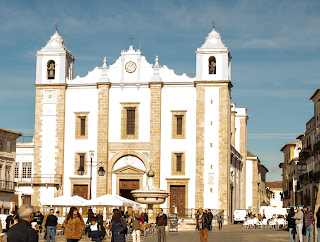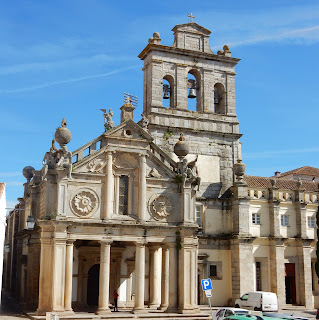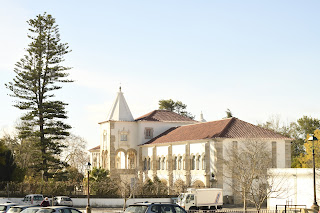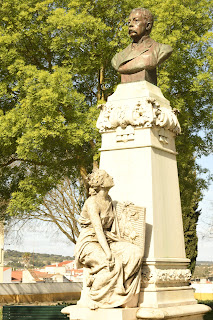Évora is a charming and historic city in central Portugal with relics from Roman and Moorish influence before and during the Medieval period, including protective walls, a temple, several cathedrals, and remains of a royal palace.
 |
| Group following the guide |
Our tour of the
UNESCO Heritage Site began with a walk through a quiet park bordering an ancient wall as a local guide provided information about the city's rich history when it was one of Portugal's cultural and educational centers.
 |
| Church of St. Francis |
And then on toward the Old Town center, stopping first at the eerie
Chapel of Bones at the Gothic-style
Church of St. Francis, its walls "decorated" by Franciscan monks with the remains of 5,000 corpses.
 |
| Bones in the Chapel of Bones |
Walking on the cobblestone street, we headed to the Old Town square of Évora, where there are shops and restaurants. People congregated to eat at tables next to a fountain, while others sat on benches along the perimeter to chat or take in the sunshine. For me, this was one of the most relaxing places on the tour.
 |
| Church of Santo Antao in Old Town square |
Now on to some other sites in this enchanting place.
 |
| Sentry post along wall |
 |
| Side street |
 |
| Temple of Diana, built in the first century |
 |
| Church of Grace |
 |
| Remains of the Royal Palace |
 |
Bust of Dr. Francisco Eduardo de Barahona,
a benefactor of the city, in the Garden of Diana |
.JPG) |
| Évora Cathedral |
After our visit to Évora, we made a stop at a cork-making factory. Wine is an important Portuguese product, so it makes sense that cork would be prominent as well.
 |
| Bark stripped from cork oak trees |
Now on to the Algarve region in the southern part of Portugal. I hope you stay along for the ride.
Until the next time . . .










.JPG)

No comments:
Post a Comment